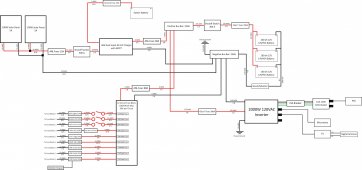Hey guys,
I'm working on putting together an RV electrical system, and I was hoping to get some feedback on the preliminary diagram that I made.
I did a lot of research as I went along, but there are some things I'm not 100% sure about. If someone could take a quick look for issues, that would be awesome!
Also, I have a few specific questions.

I'm working on putting together an RV electrical system, and I was hoping to get some feedback on the preliminary diagram that I made.
I did a lot of research as I went along, but there are some things I'm not 100% sure about. If someone could take a quick look for issues, that would be awesome!
Also, I have a few specific questions.
- Is the 250A main battery fuse adequate for the combined 12V loads and inverter load? I totaled up the amperage, and I'm right under 250A. This would also be assuming that all the components are on and running at full load simultaneously. Would I be better off going up to 300A? This would require getting higher rated bus bars and possibly cables larger than 2/0.
- Are there any locations where an additional shutoff switch would be beneficial?
- Are there any locations where a resettable breaker would be a better choice over a fuse?




